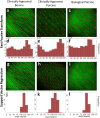Learning-enhanced 3D fiber orientation mapping in thick cardiac tissues
- PMID: 40809973
- PMCID: PMC12339308
- DOI: 10.1364/BOE.563643
Learning-enhanced 3D fiber orientation mapping in thick cardiac tissues
Abstract
Fibrous proteins, such as elastin and collagen, are crucial for the structural integrity of the cardiovascular system. For thin tissue-engineered heart valves and surgical patches, the two-dimensional mapping of fiber orientation is well-established. However, for three-dimensional (3D) thick tissue samples, e.g., the embryonic whole heart, robust 3D fiber analysis tools are not available. This information is essential for computational vascular modeling and tissue microstructure characterization. Therefore, this study employs machine learning (ML) and deep learning (DL) techniques to analyze the 3D cardiovascular fiber structures in thick samples of porcine pericardium and embryonic whole hearts. It is hypothesized that ML/DL-based fiber orientation analysis will outperform traditional Fourier transform and directional filter methods by offering higher spatial accuracy and reduced dependency on manual preprocessing. We trained our ML/DL models on both synthetic and real-world cardiovascular datasets obtained from confocal imaging. The evaluation used a mixed dataset of 1200 samples and a porcine/bovine dataset of 400 samples. Support vector regression (SVR) demonstrated the highest accuracy, achieving a normalized mean absolute error (nMAE) of 5.0% on the mixed dataset and 13.0% on the biological dataset. Among DL models, convolutional neural network (CNN) and residual network-50 (ResNet50) had an nMAE of 12.0% and 11.0% on the mixed dataset and 23.0% and 22.0% on the biological dataset, respectively. Attention mechanisms improved performance further, with the channel attention ResNet50 achieving an nMAE of 5.8% on the mixed dataset and 21.0% on the biological dataset. These findings highlight the potential of ML and DL techniques in improving 3D fiber orientation detection, enabling detailed cardiovascular microstructural assessment.
© 2025 Optica Publishing Group.
Conflict of interest statement
The authors declare no conflicts of interest.
Figures









Update of
- doi: 10.1364/opticaopen.28418294.
Similar articles
-
Prescription of Controlled Substances: Benefits and Risks.2025 Jul 6. In: StatPearls [Internet]. Treasure Island (FL): StatPearls Publishing; 2025 Jan–. 2025 Jul 6. In: StatPearls [Internet]. Treasure Island (FL): StatPearls Publishing; 2025 Jan–. PMID: 30726003 Free Books & Documents.
-
Short-Term Memory Impairment.2024 Jun 8. In: StatPearls [Internet]. Treasure Island (FL): StatPearls Publishing; 2025 Jan–. 2024 Jun 8. In: StatPearls [Internet]. Treasure Island (FL): StatPearls Publishing; 2025 Jan–. PMID: 31424720 Free Books & Documents.
-
A comprehensive analysis of recent advancements in cancer detection using machine learning and deep learning models for improved diagnostics.J Cancer Res Clin Oncol. 2023 Nov;149(15):14365-14408. doi: 10.1007/s00432-023-05216-w. Epub 2023 Aug 4. J Cancer Res Clin Oncol. 2023. PMID: 37540254 Free PMC article. Review.
-
Leveraging a foundation model zoo for cell similarity search in oncological microscopy across devices.Front Oncol. 2025 Jun 18;15:1480384. doi: 10.3389/fonc.2025.1480384. eCollection 2025. Front Oncol. 2025. PMID: 40606969 Free PMC article.
-
Management of urinary stones by experts in stone disease (ESD 2025).Arch Ital Urol Androl. 2025 Jun 30;97(2):14085. doi: 10.4081/aiua.2025.14085. Epub 2025 Jun 30. Arch Ital Urol Androl. 2025. PMID: 40583613 Review.
References
-
- Balasubramanian P., Prabhakaran M. P., Sireesha M., et al. , “Collagen in Human Tissues: Structure, Function, and Biomedical Implications from a Tissue Engineering Perspective,” Fortschritte der Hochpolymeren-Forschung 251, 173–206 (2013). 10.1007/12_2012_176 - DOI
Associated data
LinkOut - more resources
Full Text Sources
